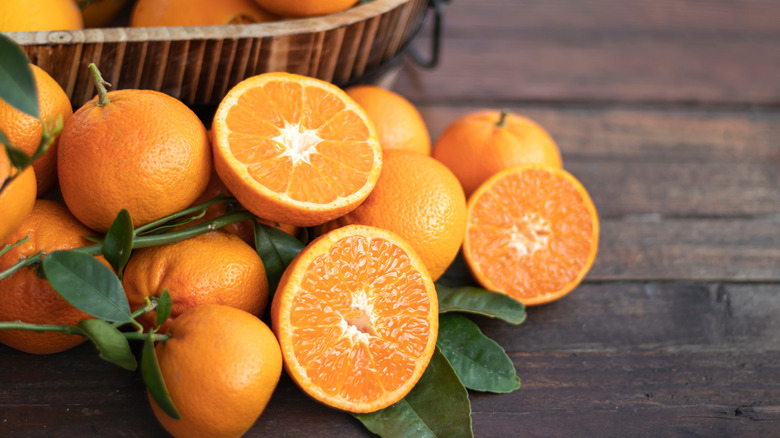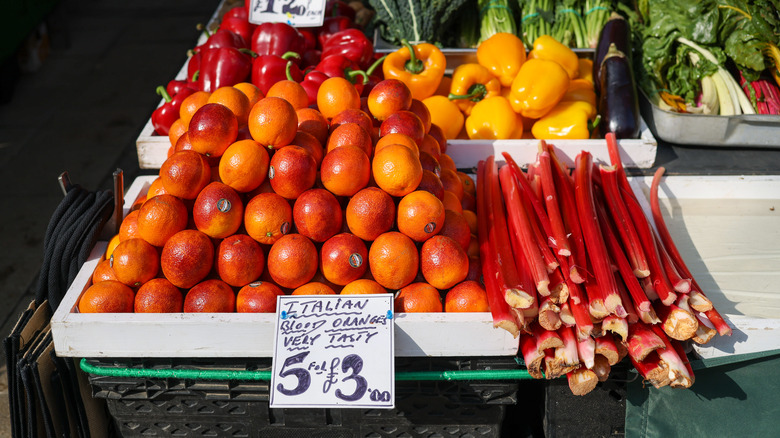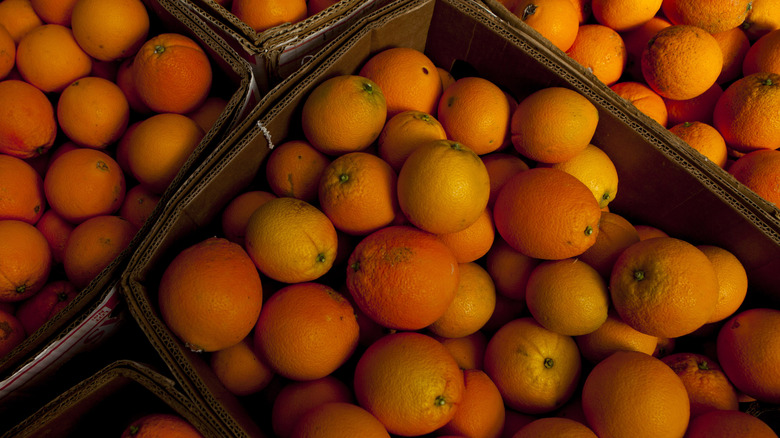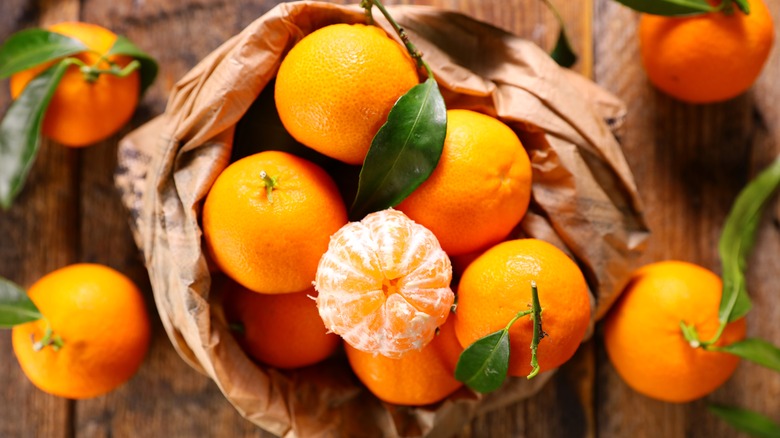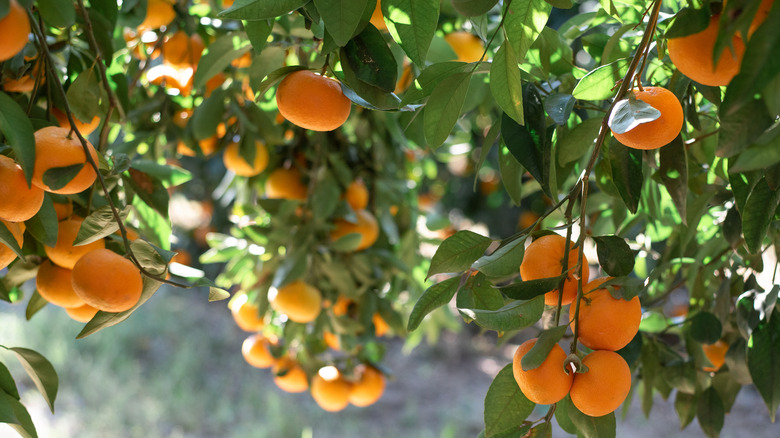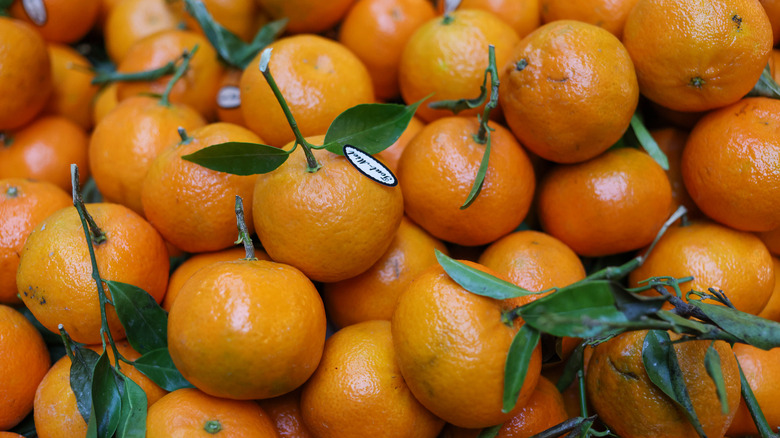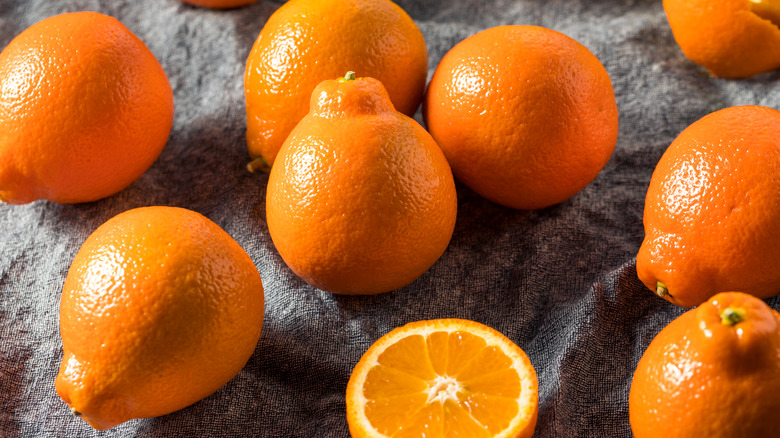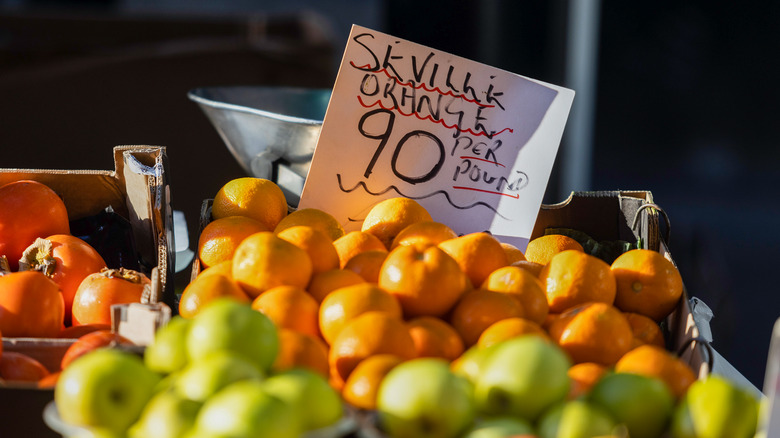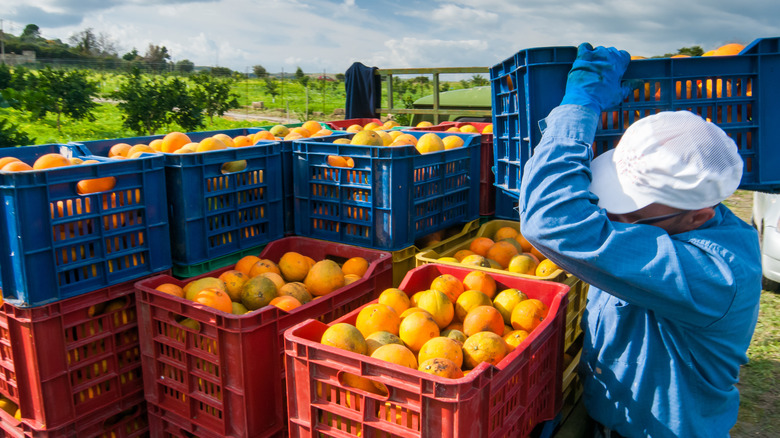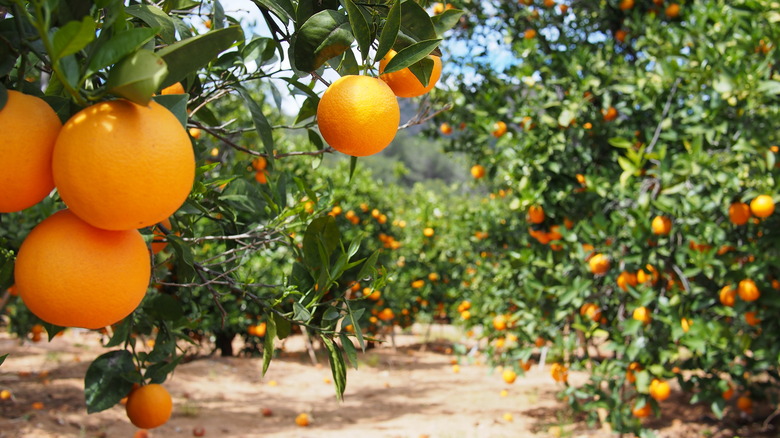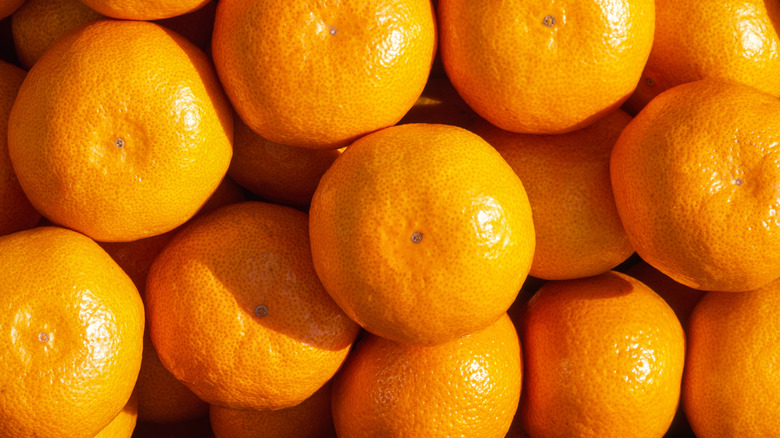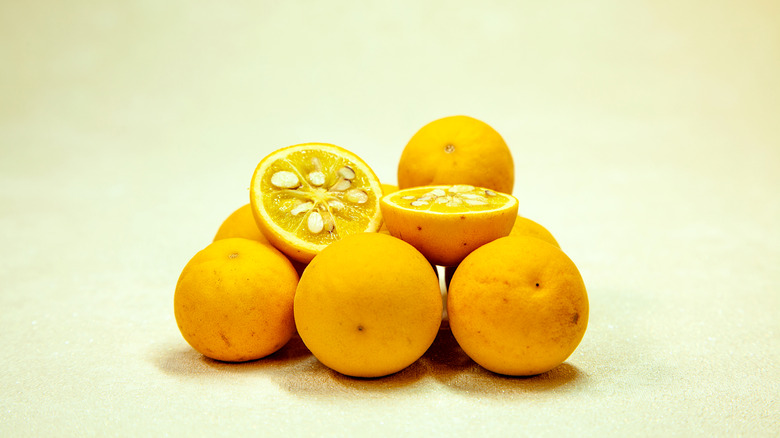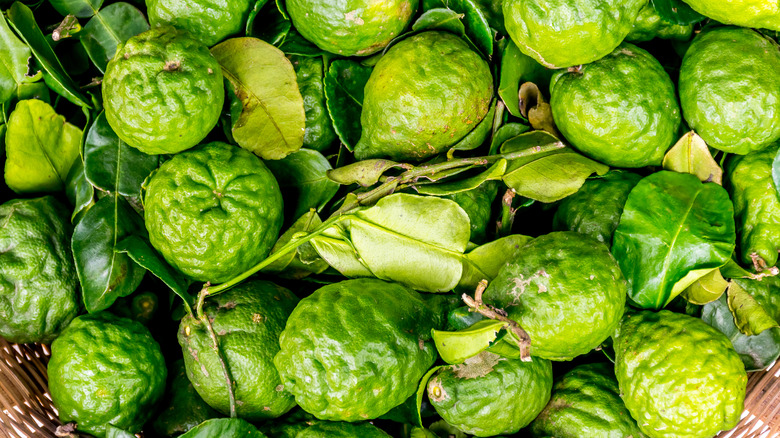13 Types Of Oranges And What Makes Them Unique
An orange is an orange is an orange ... Right? Well, not really. While you may just pick up any ol' orange at the grocery store or a carton of orange juice and think all the fruit is the same, there are actually quite a few different orange varieties and each one offers its own benefits and unique characteristics.
According to Encyclopaedia Britannica, "orange" refers to several different species in the Citrus Rutaceae family, which also includes other citrus fruits such as limes, lemons, and grapefruits. The sweet, common orange that most just simply know as an "orange" is also sometimes called the China orange (though you've likely never heard it called that). Historically native to tropical Asia, orange cultivation spread from the Malay Archipelago to India and Africa, then to the Mediterranean, and, eventually, North America and your fruit bowl.
But what if you want more than just that "common" orange? What if you want something a little more unique? You already likely know your mandarins and navels, clementines and blood oranges — but here are a few other orange varieties that you may not be familiar with, and what makes each option unique.
Blood oranges
Blood oranges are one of the most easily recognizable and most unique orange varieties. The fruit's red, vibrant hue inside gives it away instantly. Grown mostly in California and Florida, blood oranges have become increasingly popular on menus and in recipes; where you may have noticed a mandarin orange from a can in your childhood, now you'll find a trendy blood orange.
Blood oranges get their color from anthocyanin, which is just a fancy word for a color pigment that develops due to weather patterns, when you break it down to its simplest. Compared to other orange varieties, blood oranges are considered sweeter and have fewer seeds, but their growing time is relatively short, meaning they're more expensive and in demand. You'll find blood oranges in salads and on cakes, in cocktails, and even in sparkling water. The flavor can be quite polarizing, though, as one Trader Joe's blood orange cake mix with icing proved on social media.
Cara Cara oranges
The Cara Cara orange may not be as familiar to you as blood oranges and you likely couldn't recognize one on sight. A relatively new variety, Cara Cara oranges first appeared in the 1970s, at the Venezuelan Hacienda Cara Cara. A cross between two other orange varieties, Cara Cara oranges grow in the mid-winter and, like blood oranges, have a short growing season, meaning they're in high demand and can be a little pricier than your standard common orange. Cara Cara oranges contain 20% more vitamin C and 30% more vitamin A than what you'll find in navel oranges. However, it can be easy to mix up your Cara Cara oranges and your navel oranges, as they're about the same shape and size, though, once you cut into both, you'll see the Cara Cara orange is a little more similar in color, as well as taste, to a blood orange (though not as alarmingly bright).
Cara Cara oranges are also sometimes called pink or red navel oranges.
Mandarin oranges
You know mandarin oranges. These babies have been showing up in potluck salads and jello rings for decades. You probably ate them in a little plastic, pre-packaged cup when you were in elementary school or straight from the can at home. However, most of us likely know mandarin oranges from their interior versus their exterior, as they're quite popular canned rather than fresh. Mandarin oranges are typically seedless and small and can fit right in your hand, so they make for a quick, easy, and portable snack, especially for children.
While the names "mandarin orange," "tangerine," and "clementine" are often used interchangeably, they're all actually different fruits. Furthermore, mandarin oranges are technically not even really oranges, though they are in the citrus family, which makes "mandarin oranges" a bit of a misnomer.
Because of their seedless interior, the way they pull apart into segments, and how easy they are to peel, fresh mandarin oranges are popular options for quick additions to desserts and salads.
Tangerines
The interchangeable use of the terms "tangerine" and "mandarin" can make for some confusing conversations, but S&J Mandarin Grove puts things in simpler terms: Much like all bourbon is whiskey, but not all whiskey is bourbon, all tangerines are mandarins, but not all mandarins are tangerines. The producer explains that the term "mandarin" can refer to a larger group of fruits that fall beneath its umbrella. When it comes to tangerines, they're typically bright orange and, compared to a textbook mandarin, are on the tarter side and not quite as easy to peel. To muddle the agricultural waters a bit further, tangerines have been used to create even more citrus varieties, such as the Temple Orange, which is a cross between a tangerine and a textbook mandarin, and the Minneola Tangelo, which is a cross between a grapefruit and a tangerine.
Whatever you call it, tangerines offer a taste of summertime sweetness and childhood memories for many who enjoy this unique citrus fruit.
Clementines
So then what's the difference between clementines and a mandarin or tangerine? Again, the experts at S&J Mandarin Grove say that, much like a tangerine, all clementines are mandarins, but not all mandarins are clementines. Out of all the fruits in the mandarin family, clementines are the smallest. They're incredibly sweet, shiny, delicious, seedless, and vibrantly colored inside and out. You may know clementines more commonly by the popular grocery store brand name, Cuties. Clementines' extra sweetness makes them popular with children, as well as those looking for a healthier sweet treat, though be careful just how many clementines you eat.
While those Cuties can go down quickly, eating too many fruits of the acidic orange variety can be hazardous to your health. In high doses, the acidic content can create digestive issues, especially in those who already suffer from acid reflux, and the extra potassium content can cause further health issues.
Tangelos
A tangelo is a cross between a grapefruit and a tangerine. They look a little like an orange on the outside, but with a characteristic bumpy nub on one end. They boast a sweet-sour flavor and there are a few different subspecies of tangelos that combine various different types of grapefruits and tangerines, but they all give you the tartness of a grapefruit with the sweetness of a tangerine. Very versatile, they can be used just about anywhere you'd use a common orange.
Do note that a sub-species of tangelo oranges actually go by a totally separate name that you might recognize: Ugli fruit, or the Jamaican tangelo. Ugli fruit, which is a registered and trademarked name, looks quite different from its typical tangelo cousins, as it leans more yellow and green than orange in coloring. According to the company that owns the Ugli variety, this particular type of tangelo was discovered growing wild in Jamaica less than a century ago, and was believed to be a naturally-occurring hybrid between a Seville orange, grapefruit, and tangerine.
Seville oranges
Seville oranges are one of the more unique oranges you'll find, due to their flavor. Also sometimes called a sour orange or bitter orange, Seville oranges aren't sweet in the slightest, which means you'll be hard-pressed to find many who enjoy eating the oranges raw. Instead, the juice, rind, and zest are used in various recipes, such as English marmalade. The oranges have a high pectin content that helps naturally set the marmalade and the sour flavor nicely contradicts the marmalade's sweetness.
Unfortunately, Seville oranges aren't very easy to find. You'd do best looking for them at your local health foods store or international grocery store. Make sure to look for them under all of their various names. If all else fails and you just can't find a seville orange for use in a recipe that calls for one replicate the flavor by mixing two parts orange juice to one part lime juice (via New York Times).
Navel oranges
Navel oranges can be easy to mix up with both Cara Cara oranges and blood oranges, but there are a few key differences. This highly popular orange is named for its belly button-like hole that, when peeled, reveals a second, undeveloped fruit. Transported from Brazil to the United States in the late 1800s, navel oranges come in their own swathe of varieties, with up to 50 different types of navel oranges grown everywhere from Florida to California to Washington to Brazil. Naturally seedless, navel oranges are popular for eating fresh as well as using in recipes, but not so much for juicing.
When compared to Cara Cara oranges, navel oranges are a little milder in taste, though still sweet, and are usually more yellow-orange on the inside. This hue differs from the red color of blood oranges as well, and the two differ in terms of growing season. Navel oranges also feature more vitamin C content.
Valencia oranges
Valencia oranges are closely related to Cara Cara oranges, blood oranges, and navel oranges, but are unique in their own ways. Medium-sized and bright orange inside and out, with little to no yellow or pink coloring, a Valencia orange is like the textbook image of what you'd imagine a basic orange to look like. The only color deviations you might see are a few patches of green that appear during the ripening process. They're also the primary type of orange used for orange juice, partially because they don't contain limonin, a compound that causes a bitter flavor in some citrus juices. This also makes the oranges popular for cooking and baking, and they're quite often paired with pork or chocolate. Similarly, Valencia oranges are standard enough to be used in any recipe that doesn't specify a particular type of orange.
As a whole, if you're looking for a common sweet orange, Valencia oranges are about as common and popular as it gets.
Satsuma oranges
Satsuma oranges are cousins to tangerines and clementines, another one of those oranges that is a mandarin, but at the same time, not a mandarin. Named after a former Japanese province, Satsuma oranges are approximated to have been cultivated as early as the 1500s, before being transported to Florida in the late 1800s. Today, California grows most of the United States' Satsuma oranges.
While Satsuma oranges are similar in appearance and size to both tangerines and clementines, the sweet-tart Satsumas stand apart in two key ways: more juice and less pulp. Those who prefer a packed-to-the-gills juicy orange and as little pulp as possible will love these oranges. Unfortunately, Satsumas can be difficult to find due to their seasonality and are most popular in the winter months.
Don't think you've ever had a Satsuma before? While you may not have enjoyed one of these fruits fresh, you may have actually eaten them without realizing it, as they're often canned and sold as simply mandarins, versus under their actual name.
Jaffa oranges
Jaffa oranges originated in present-day Israel in the 1800s and were written about in western historical documents soon after. Even Queen Victoria enjoyed the occasional Jaffa orange (via Tablet Magazine). Soon, the oranges, which were highly prized for their quality, were being shipped to England at a rate of nearly 20,000 cases per orange season, with up to 150 oranges in each case.
The oranges are less popular in England now, due to more affordable orange varieties being available. However, the English honor their beloved Jaffa oranges through the Jaffa cake, which features a round orange cake with a jammy bit between the sponge and a layer of chocolate that's been flavored with tangerine oil. There are also English stories about Richard the Lionheart bringing Jaffa oranges to England — though that's quite impossible given that he lived in the 1100s and the oranges weren't developed until the 1800s.
Trifoliate oranges
Trifoliate oranges are not, as you might expect, some odd orange-lemon-grapefruit hybrid that some agricultural enterpriser decided to make one day on a whim. Instead, it's one of the hardiest members of the orange family; it can thrive even at below-freezing temperatures.
Originally grown in China and North Korea, the tall, shrubby trees produce small, egg-shaped fruit that feature thick, yellow exteriors. The flavor is lemony and sour and the fruit is generally considered inedible raw, though tasty when cooked or used medicinally. One recipe humorously recommends combining one raw trifoliate orange with one barrel of sugar and one barrel of water to get an edible version of trifoliate orange lemonade. Popular culinary uses include jams and jellies. Medicinal uses include treatments for inflammation, nausea, and allergies. However, some caution that if these oranges are eaten in large quantities, the high acidity can cause stomach pain, nausea, or skin irritation, which is why some merely use the trees as decorative landscaping. The fruit also contains little actual fruit and is primarily seed.
Bergamots
You may have heard of bergamots in connection to tea; it's used to flavor the Earl Grey variety. However, while the name is familiar, you likely couldn't recognize bergamot on sight. The fruit looks nothing like a traditional orange. Light green on the outside and yellow to green on the inside, bergamot oranges taste tart and spicy. The essential oils from the fruit's rind are used in Earl Grey tea, but also cosmetics and beauty products.
Much like the trifoliate orange, though, this is one citrus fruit you won't want to eat on its own. Fresh, the bergamot is startlingly sour, so most use is kept to those essential oils. Beyond just flavoring tea, the oils can be used to help with stress, anxiety, depression, digestion, and pain. It's pretty rare to even spot bergamot fruit whole at a grocery store or farmers market, but if you do, Bon Appétit recommends using the zest in baking or cocktails, or using the juice in any cocktail where you might normally use grapefruit, lemon, or lime juice.
